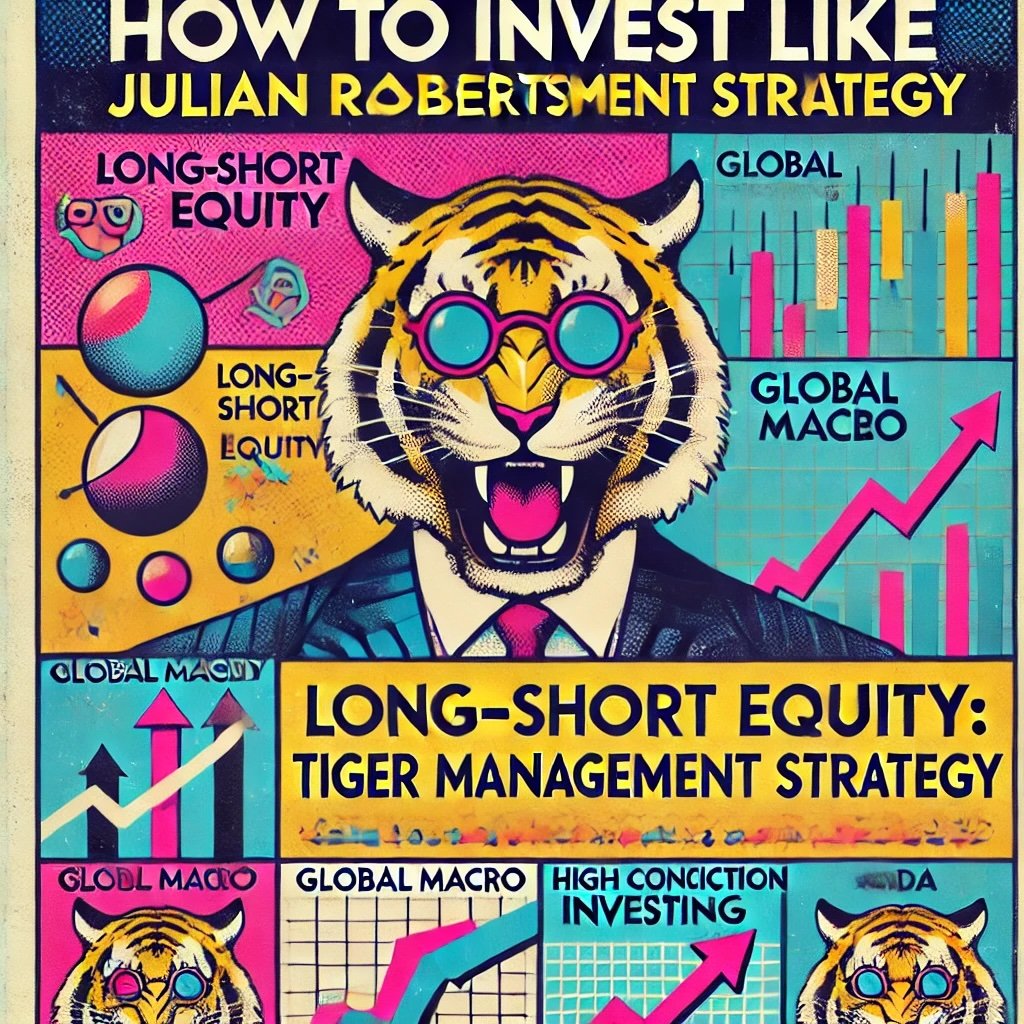Welcome to the world of FIRE – a lifestyle concept that stands for “Financial Independence, Retire Early”. This isn’t about dousing yourself in gasoline and striking a match, rather it’s a journey of financial transformation with the power to ignite your life in extraordinary ways. The acronym might be blazing hot, but the principle behind it is as cool as a cucumber. Financial Independence, Retire Early, is about liberating yourself from the traditional concepts of work, earning, and retirement.
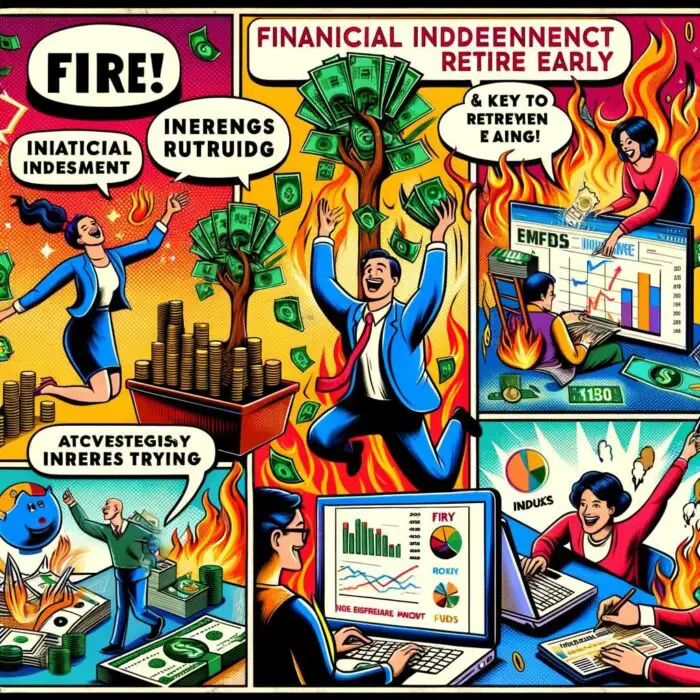
This pathway leads to a state where your assets generate enough income to cover your expenses without you needing to trade your precious time for money. You’re independent because you’re not shackled by financial constraints, and you can choose to retire early, swap jobs, start a business, travel the world, or dedicate your time to causes that matter to you.
The Importance and Benefits of Pursuing FIRE

Pursuing FIRE isn’t just about the allure of an early retirement or escaping the rat race (although those are pretty compelling reasons). It’s a conscious journey toward greater financial awareness, discipline, and resilience. This lifestyle strategy offers a smorgasbord of benefits beyond the obvious ones.
For starters, achieving FIRE means financial security and peace of mind. No more sleepless nights worrying about paying bills or unexpected emergencies. Next, it offers you the gift of time – to spend with family, pursue hobbies, and enjoy life at a pace you control, not the one dictated by a 9-5 job.
Lastly, the path to FIRE fosters personal growth and empowerment. As you build your financial literacy, you’re not just learning about money, you’re learning about life, decision-making, risk management, and resilience. These are skills that go beyond the bank account and permeate all aspects of your life.
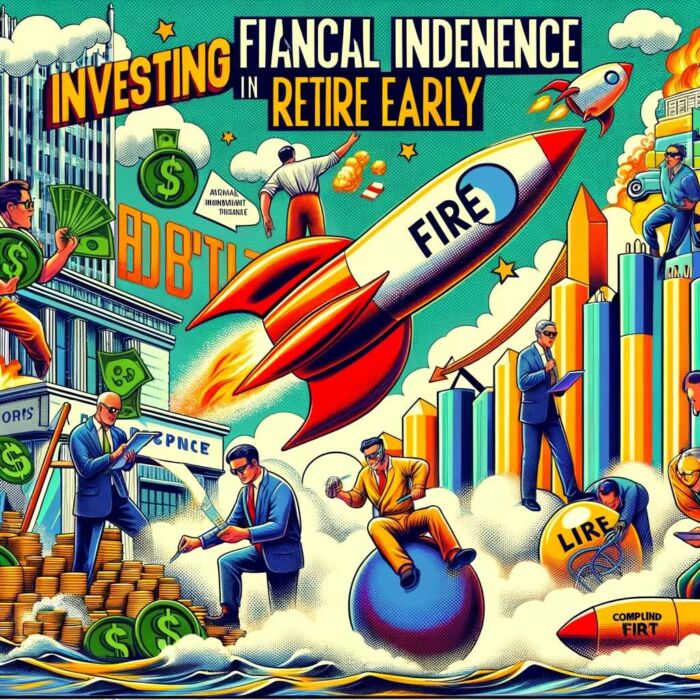
The Role of Investing in Achieving FIRE
Now that we’ve kindled your interest in FIRE, let’s add some fuel to the flame. One of the crucial elements in the pursuit of FIRE is investing. Saving alone won’t get you there – unless you’re planning to win the lottery or inherit a fortune. To achieve FIRE, you need to make your money work for you, and that’s where investing shines.
Investing is the vehicle that propels you on your FIRE journey. It’s about taking the wealth you’ve earned and putting it to work in income-generating or value-appreciating assets. Whether it’s investing in stocks, bonds, real estate, or other types of investments, the goal is the same – to grow your wealth exponentially over time.
The power of investing lies in compounding – the process by which the earnings from an investment, in turn, earn their own returns. It’s like a snowball rolling downhill, gathering more snow and momentum as it goes. Over time, this process can turn modest savings into a hefty nest egg that can fuel your financially independent and early retirement lifestyle.
Understanding how to invest wisely, manage risks, and create a diversified portfolio is integral to your FIRE strategy. This is what we will discuss in the following sections, lighting the way toward your financial independence and early retirement. Buckle up and get ready for an exciting journey towards a life where you have the power to control your time, your money, and your destiny.
source: FIRE Psy Chat on YouTube
Understanding the Basics of Investing
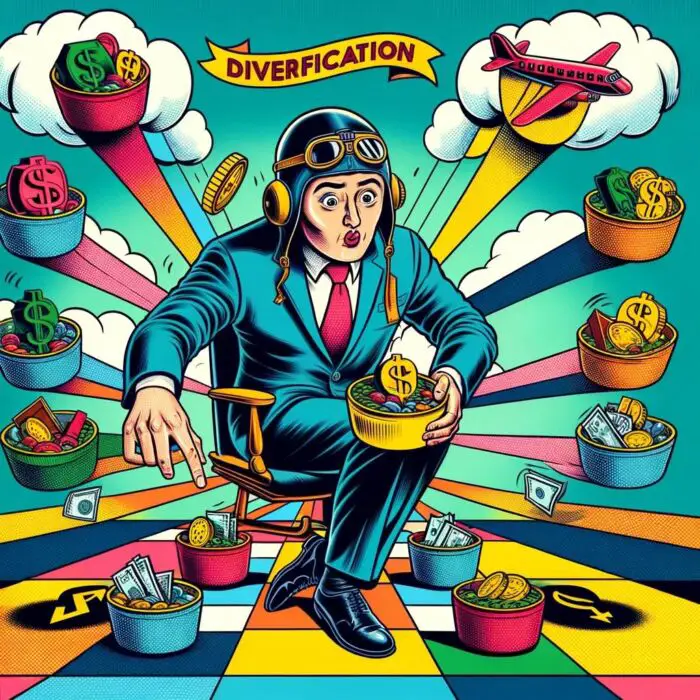
The Principles of Investing
Investing isn’t about wild gambles or betting on the next hot stock mentioned on social media. It’s a well-considered, systematic strategy. It’s like baking a cake – you need the right ingredients, the right proportions, and patience. Let’s look at some fundamental ingredients of investing: diversification, risk vs. reward, and compounding.
Diversification: The saying “don’t put all your eggs in one basket” holds for investing too. When you diversify your portfolio, you spread your investments across different asset classes like stocks, bonds, real estate, etc. The idea is that if one investment goes south, you have others that may be performing well, cushioning your overall losses. Diversification can be thought of as a seat belt for your portfolio, it won’t prevent a crash, but it can help minimize the injuries.
Risk vs. Reward: In investing, risk and reward are two sides of the same coin. Typically, the potential for higher returns comes with a higher level of risk. Understanding your risk tolerance is crucial. It’s about finding that sweet spot where you’re comfortable with the level of risk and the potential return on investment. It’s a bit like deciding whether to dive into the deep end of the pool – exciting for some, terrifying for others. Knowing your comfort level helps you make decisions that you can live with, and sleep at night.
Compounding: Albert Einstein supposedly called compounding the eighth wonder of the world. Whether he actually said that is up for debate, but compounding’s magical effect on investments isn’t. When you reinvest the returns from your investments, you start earning returns on those returns. It’s like a snowball effect – the longer the time, the bigger your investment snowball gets. Think of it as a friendly money-making snowman that gets bigger and jollier over time!

Different Types of Investments
Ready to start building your financial cake? Let’s meet some of the ingredients – different types of investments.
Stocks: When you buy a company’s stock, you’re buying a piece of that company. You become a part-owner. If the company does well, you could make money through increased share prices or dividends – a share of the company’s profits. If the company doesn’t do well, the share price might fall. Stocks can be a bit like a roller coaster ride – thrilling for some, queasy for others!
Bonds: Buying a bond means you’re lending money to the issuer (like a government or a corporation) for a set period. In return, you receive interest payments over that period and the principal amount at maturity. Bonds are often seen as the “safer” route on the investment highway, providing regular income and lower volatility than stocks.
Real Estate: Real estate investing can range from buying rental properties to investing in Real Estate Investment Trusts (REITs). The primary ways you make money from real estate are rental income and property appreciation. Investing in real estate can be like having your own golden goose, as properties may generate a steady stream of rental income and potentially appreciate in value over time.
Others: Other types of investments include mutual funds, index funds, ETFs, options, commodities, and more. The financial market is like a vast ocean teeming with different species of investment fish. It’s up to you to decide which ones you want in your investment net!
Having an Investment Strategy for FIRE
Just as a ship needs a compass to reach its destination, you need an investment strategy to reach FIRE. An investment strategy is your financial road map – it defines your destination (your FIRE number), the route (how you’ll invest), and the timeline (when you plan to retire).
Your investment strategy helps you stay focused and disciplined, preventing you from making impulsive decisions based on market fluctuations or the latest investment fads. It’s like your personal financial trainer, keeping you in line, pushing you towards your goals, and helping you adjust your plan as life and markets evolve.
Your FIRE journey isn’t going to be a sprint. It’s a marathon. It requires patience, resilience, and discipline. Having a solid investment strategy acts as your guiding star, helping you navigate through the dark and stormy nights, and leading you to the golden dawn of financial independence and early retirement. And with that, let’s move on to setting those financial goals that will light up your path to FIRE.

Setting Financial Goals for FIRE
Determining Your FIRE Number
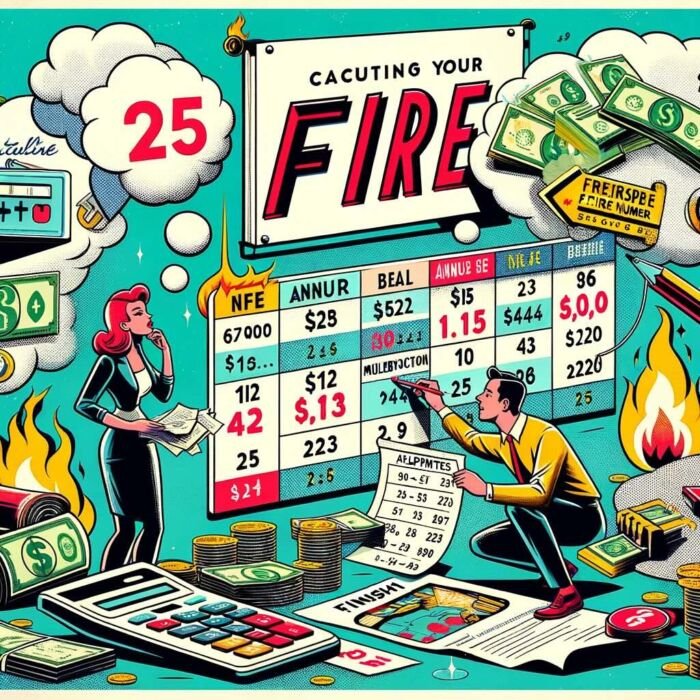
Determining your FIRE number is like marking the treasure spot on your financial map. This is the total amount of money you need to retire early and maintain your desired lifestyle. But how do you calculate this magical figure? It’s a multi-step dance that begins with understanding your annual expenses.
First, you need to calculate how much you spend each year, including housing, food, healthcare, leisure activities, and all other costs. Once you have a solid grip on your annual expenses, the general rule of thumb is to multiply that number by 25, based on the 4% safe withdrawal rate. For example, if you spend $40,000 a year, your FIRE number would be $1,000,000 ($40,000 x 25).
It’s important to note that everyone’s FIRE number will be different. It’s as unique as your fingerprint, shaped by your lifestyle, goals, and risk tolerance. Your FIRE number is your personal finish line, the golden number that sets you free.
Budgeting and Saving for Investment
Budgeting and saving aren’t just good habits, they’re the lifeblood of your FIRE journey. Think of them as your financial workout, strengthening your money muscles and powering you towards your FIRE number.
Budgeting is about knowing where your money is going and making intentional decisions about spending. It’s your financial diet plan, helping you trim the fat and boost your financial health. With a clear budget, you can prioritize your spending and direct more money towards your investment fund.
Saving is the next step. It’s the difference between what you earn and what you spend, and it’s the primary source of funds for your investments. The more you save, the more you can invest, and the faster you can reach your FIRE number. It’s a bit like a financial relay race – the baton is passed from earning to saving to investing, each step bringing you closer to your goal.
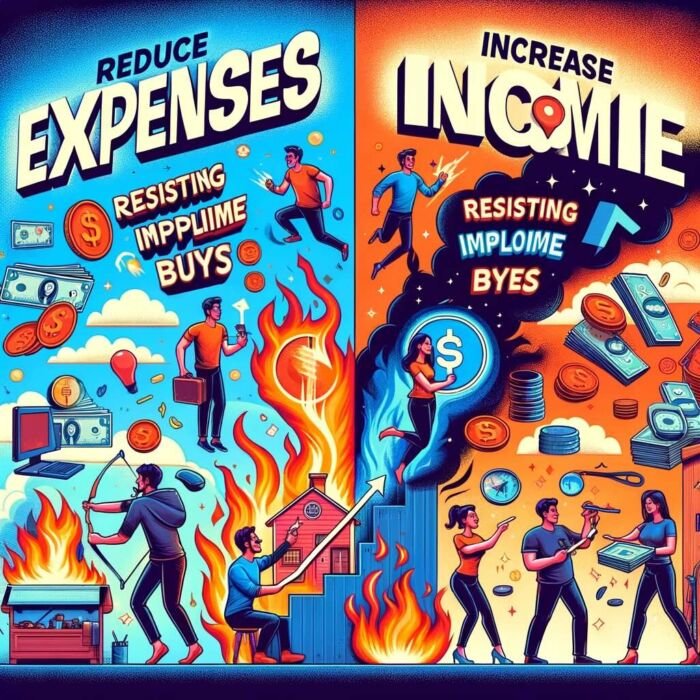
How to Reduce Expenses and Increase Income
If budgeting and saving are your financial workout, then reducing expenses and increasing income are your power moves. They’re like turbochargers that can speed up your journey to FIRE.
Reducing expenses isn’t just about cutting back or living frugally. It’s about optimizing your spending, getting the most value out of every dollar. Here are some tips:
- Track Your Spending: Keep a close eye on where your money is going. This will help you identify areas where you can cut back.
- Avoid Impulse Purchases: Make a shopping list and stick to it. Give yourself a cooling-off period before making big purchases.
- DIY: From home repairs to cooking meals at home, doing it yourself can save you a lot of money.
Increasing income, on the other hand, is about tapping into your potential and finding ways to earn more. Here are some ideas:
- Ask for a Raise or Promotion: If you’ve been adding value to your company, it might be time to negotiate for a higher salary.
- Freelancing or Side Gigs: Use your skills to earn extra money outside your regular job.
- Invest in Yourself: Learn new skills or improve existing ones to increase your earning potential.
Reducing expenses and increasing income are like two engines propelling your financial plane. With both working together, you’ll be soaring towards your FIRE goals. So, strap in and prepare for takeoff! Next, we’ll explore some of the top investment strategies for FIRE.
source: Shankar Nath on YouTube
Top Investment Strategies for FIRE
Index Fund Investing
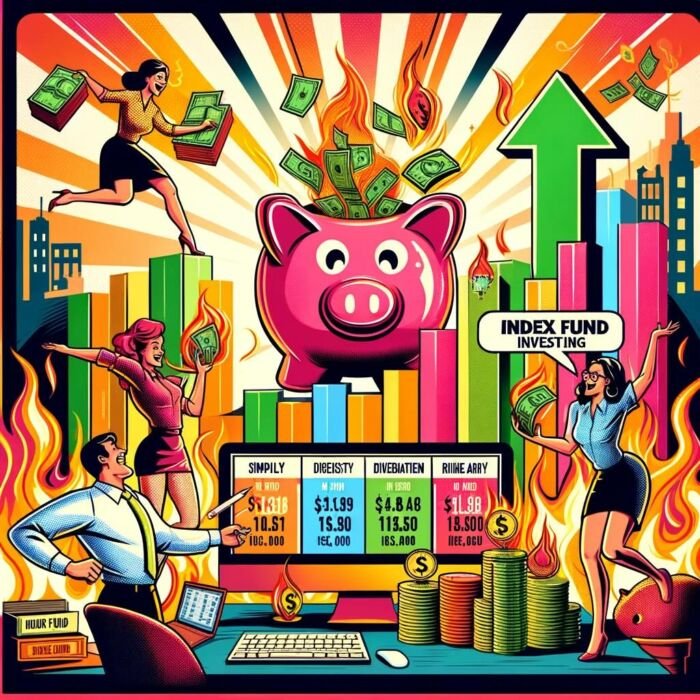
Definition and Advantages
An index fund is a bit like a music album, giving you a collection of different hits, each a superstar in its own right. In financial terms, an index fund is a type of mutual fund or exchange-traded fund (ETF) designed to mimic the performance of a specific market index, like the S&P 500 or the Nasdaq 100. Instead of trying to beat the market (a challenging task, even for professional money managers), an index fund aims to mirror it.
Index fund investing comes with several key advantages. First, it provides instant diversification. Instead of buying shares in just one company, you’re buying a tiny piece of all the companies in the index. It’s like getting a financial tasting menu featuring the best of the market.
Second, index funds are generally cost-effective. Because they’re passively managed (i.e., the fund manager just replicates the index rather than actively picking stocks), the expense ratios are usually low. Think of it as getting a first-class financial journey at economy-class prices.
Lastly, history has shown that over the long term, most active fund managers fail to outperform the market consistently. By investing in index funds, you’re banking on the entire market’s performance, which has generally trended upwards over long periods. It’s like betting on the economic progress of the world rather than the fortunes of individual companies.
Role in a FIRE Strategy
In the FIRE strategy, index fund investing plays the part of a dependable workhorse, a slow and steady performer that can reliably grow your wealth over time. It’s like the tortoise in Aesop’s fable – it may not provide the adrenaline rush of a hare, but its steady pace can win the retirement race.
The diversification, low costs, and historical performance of index funds make them a solid foundation for your FIRE investment portfolio. As they say, it’s time in the market, not timing the market, that builds wealth. With index fund investing, you’re harnessing the power of the market, letting it work its magic over time.
It’s also worth noting that index fund investing aligns well with the principles of FIRE, which promote simplicity, efficiency, and a long-term perspective. Investing in index funds simplifies your investment strategy, frees up time for you to enjoy life, and can help you maintain your financial flame until you reach your FIRE goals.
As we continue on our journey to FIRE, let’s explore other investment strategies that can add more fuel to your financial fire.

Dividend Investing
Definition and Advantages
Dividend investing is like owning a money tree that regularly drops cash right into your lap. In financial terms, it’s an investment strategy focused on buying stocks that pay dividends – a portion of a company’s earnings distributed to shareholders.
One key advantage of dividend investing is the regular income it provides. These dividend payments can be a welcome cash flow, particularly for early retirees who may not have a regular paycheck. Dividend investing is like having a tenant (the company) who regularly pays you rent (dividends) for owning a part of the property (the stock).
Another advantage is the potential for a double win. You could profit from the stock’s price appreciation and the dividend payments. It’s like owning a goose that lays golden eggs while also growing fatter over time.
Additionally, companies that consistently pay dividends are often well-established and financially stable, making them potentially less risky investments. It’s like choosing a reliable old tortoise over a flashy, unpredictable hare.
Role in a FIRE Strategy
In a FIRE strategy, dividend investing is the seasoned performer, the rock star belting out regular hits. It’s an investment strategy that can provide both income and growth, helping to fuel your journey to financial independence.
Dividend investing can play a crucial role in your FIRE strategy by providing regular income even before you retire. This can be especially beneficial during market downturns when selling stocks might not be favorable. You could use the dividends to cover living expenses or reinvest them, purchasing more shares and boosting future dividends in a virtuous circle.
Moreover, companies that regularly pay dividends and have a history of increasing them over time can offer an inflation-beating income stream. This is particularly relevant for early retirees who need their income to keep pace with rising living costs over a longer retirement period.
Remember, though, that not all dividend-paying stocks are created equal. Like all investments, they come with risks. It’s essential to consider the company’s overall health, dividend payout ratio, and growth prospects. The goal is to find companies that can pay and increase dividends consistently, not just those offering the highest yield.
As we continue to stoke the FIRE, let’s delve into another investment strategy that can provide both income and growth – real estate investing.
Real Estate Investing
Definition and Advantages
Real estate investing is like having a golden goose in your backyard that lays eggs in the form of rental income and property appreciation. Simply put, it involves purchasing property (like residential houses, commercial buildings, or land) with the intention of earning a return. This return can come from rental income, the resale of the property, or both.
One significant advantage of real estate investing is the potential for consistent income through rentals. It’s like having a tenant who regularly pays you rent for living in or using your property. This consistent cash flow can be a solid base for your FIRE journey.
Another advantage is the potential for capital appreciation. Over time, real estate values have generally increased, meaning that you could make a profit when you sell your property. It’s like planting a sapling and watching it grow into a money tree.
Moreover, real estate can be a powerful hedge against inflation. As living costs rise, so often does the value of property and rental income, helping to protect your purchasing power. It’s like having a financial shield, safeguarding your wealth from the eroding effects of inflation.
Role in a FIRE Strategy
In the orchestra of a FIRE strategy, real estate investing plays the part of the sturdy double bass, providing a steady rhythm of income and growth potential. It’s a strategy that can offer both stability and significant returns, adding another layer of diversification to your investment portfolio.
One of the primary ways real estate investing can fuel your FIRE journey is through rental income. This regular income stream can cover a part or all of your living expenses, helping you reach your FIRE number sooner. It’s a bit like having a financial patron who sponsors your journey to financial independence.
Moreover, real estate can play a significant role in your post-FIRE strategy. The ongoing rental income can sustain your retirement lifestyle without having to sell off your assets. And if you need a lump sum, you have the option to sell a property.
However, it’s important to remember that real estate investing isn’t a one-size-fits-all strategy. It requires research, management, and sometimes, dealing with tenants and maintenance issues. Also, the cost of entry can be high, and properties can be difficult to sell quickly. But with careful planning and execution, it can be a powerful engine driving your journey to FIRE.
With this, we have explored some of the top investment strategies for FIRE. But, our journey doesn’t end here. Let’s move on to discuss the importance of consistency, discipline, and resilience on your path to FIRE.
source: Our Rich Journey on YouTube
Bond Investing
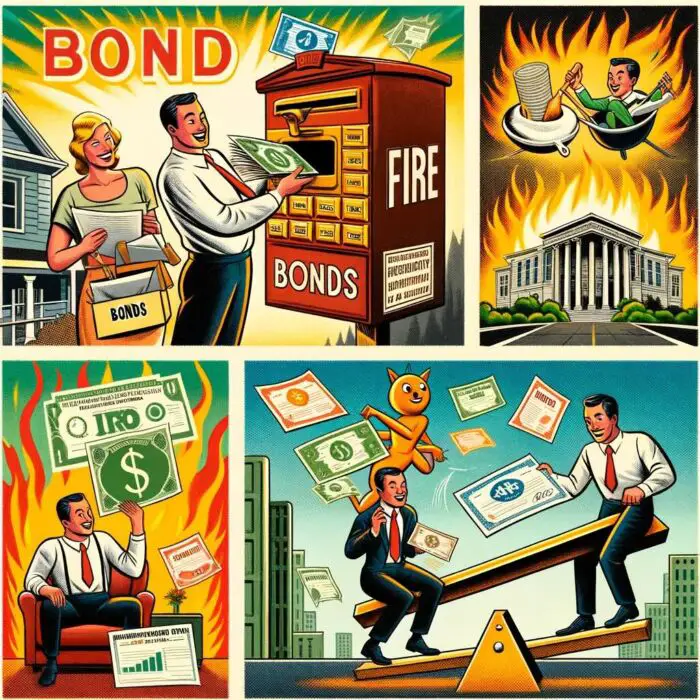
Definition and Advantages
Bond investing is like lending money to a friend who promises to pay you back with interest over a specified time. In financial terms, when you purchase a bond, you’re lending money to the bond issuer (which could be a government, municipality, or corporation) in exchange for regular interest payments and the return of the original amount (principal) at the end of the bond’s term (maturity date).
One of the main advantages of bonds is the predictability of income. When you buy a bond, you know exactly when and how much you will receive in interest payments, assuming the issuer doesn’t default. This predictable income stream can be a steady breeze in your financial sails, helping you navigate the uncertain waters of the market.
Another advantage of bonds is their potential for preserving capital. Unlike stocks, which can fluctuate wildly in value, bonds promise to return the original investment amount at maturity. This can be particularly beneficial in volatile markets, acting as a financial anchor, keeping your portfolio steady amid the storms.
Lastly, bonds can offer diversification benefits. Bond prices often move differently than stock prices, meaning they can help balance out portfolio swings and potentially reduce overall risk. It’s a bit like having different dancers in your financial ballet, each moving to their own rhythm but together creating a harmonious performance.
Role in a FIRE Strategy
In a FIRE strategy, bond investing is the reliable drummer, keeping a steady beat amidst the rocking guitars and soaring vocals of other investments. It’s a strategy that offers stability and predictability, two qualities that can be invaluable on your journey to FIRE.
Bonds can play a crucial role in your FIRE strategy by providing a regular and predictable income stream. This income can supplement your other earnings or provide a cushion during market downturns, helping to smooth out your financial journey.
Additionally, bonds can help preserve your capital, particularly as you get closer to your retirement date. As the saying goes, “you don’t want to be forced to sell stocks when the market is down.” By having a portion of your portfolio in bonds, you can avoid dipping into your stocks during unfavorable market conditions.
However, keep in mind that while bonds are generally considered less risky than stocks, they are not risk-free. There’s the risk of the issuer defaulting and not being able to make the promised interest payments or return the principal. Moreover, bonds are sensitive to interest rate changes, and their value can decrease if interest rates rise.
As with all investments, a thoughtful and well-researched strategy is crucial. Consider factors such as the bond’s rating (a measure of its creditworthiness), maturity date, and yield before making a purchase.
Now that we’ve explored the stable beat of bond investing let’s continue to discuss other essential elements in achieving FIRE.
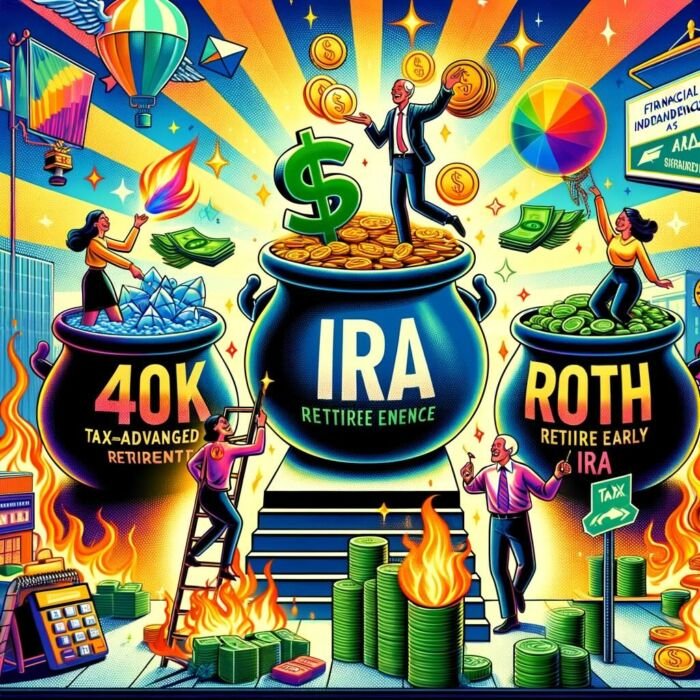
Tax-Advantaged Retirement Accounts (401(k), IRA, Roth IRA)
Definition and Advantages
Tax-advantaged retirement accounts, including 401(k)s, Traditional IRAs, and Roth IRAs, are like magical pots at the end of the financial rainbow. They’re specially designed accounts that come with significant tax benefits to encourage long-term saving for retirement.
A 401(k) is a type of retirement savings plan sponsored by an employer. It allows workers to save and invest a portion of their paycheck before taxes are taken out. Taxes aren’t paid until the money is withdrawn from the account.
Traditional IRAs (Individual Retirement Accounts) work on a similar principle. Contributions may be tax-deductible, meaning they reduce your taxable income for the year, and the investments grow tax-deferred until retirement when withdrawals are taxed as income.
A Roth IRA, on the other hand, offers a different type of tax advantage. Contributions are made with after-tax dollars, meaning there’s no tax break on the amount you invest today. However, earnings and withdrawals in retirement are tax-free, provided certain conditions are met.
The main advantage of these accounts is their favorable tax treatment. They allow your investments to compound over time either tax-free or tax-deferred, turbocharging your savings growth. It’s like adding a secret ingredient to your financial recipe that makes your wealth pie rise faster.
Another advantage is the potential for employer-matching contributions in the case of 401(k)s. Many employers will match a percentage of what you contribute to your 401(k), essentially offering free money. It’s like getting a performance bonus just for saving for your future.
Role in a FIRE Strategy
In a FIRE strategy, tax-advantaged retirement accounts play the part of the powerful bass, adding depth and resonance to your financial melody. They’re a cornerstone of effective retirement planning, providing a legal pathway to reduce taxes and accelerate wealth growth.
Maximizing contributions to these accounts can play a pivotal role in reaching FIRE. The tax savings can be significant, and the compounding effect over time can dramatically boost your nest egg’s size.
However, there’s a crucial point to consider in a FIRE context: early withdrawal penalties. Generally, withdrawing from these accounts before age 59.5 incurs a penalty. However, there are strategies (like the Roth IRA conversion ladder or the Rule of 55 for 401(k)s) that FIRE followers use to access these funds earlier without penalty. It’s important to plan carefully and possibly consult with a financial advisor to navigate these rules successfully.
Remember, the path to FIRE isn’t about choosing just one of these strategies but deploying a mix that suits your financial situation, risk tolerance, and early retirement goals. The symphony of FIRE involves all these instruments playing together, leading you towards the grand crescendo of financial independence and early retirement.
Diversification and Asset Allocation

Diversification and Its Importance
Diversification is a bit like going to a buffet. Instead of loading your plate with just one type of food, you take a bit of everything. In investing terms, it means spreading your investments across different asset classes (stocks, bonds, real estate, etc.) and within asset classes (different sectors, geographical regions, etc.).
Why does diversification matter? Imagine going to that buffet and discovering your favorite dish has gone bad. If that’s all you have on your plate, you’re out of luck. But if you’ve chosen a variety of dishes, your meal isn’t ruined. In the same way, diversification can protect your investment portfolio from the “bad apples.” If one of your investments underperforms, the others can potentially balance out the losses.
How to Create a Diversified Investment Portfolio
Creating a diversified portfolio is like planting a well-rounded garden. You don’t want just one type of plant. You want a mix that can thrive in different conditions and at different times of the year. Here’s how you can do it:
- Mix Up Your Assets: Include different asset classes like stocks, bonds, and real estate in your portfolio. Each asset class has its own growth potential and risks, and they often perform differently under various market conditions.
- Diversify Within Each Asset Class: For example, don’t just buy stocks from one company or one sector. Spread your investments across various industries and companies of different sizes. Similarly, consider bonds with different maturity dates and issuers.
- Think Global: Don’t limit yourself to your home country. International investments can offer additional opportunities for growth and diversification.
- Rebalance Regularly: Over time, some investments may grow faster than others, skewing your original asset allocation. Regular rebalancing ensures your portfolio maintains the desired level of diversification.
Importance of Asset Allocation in Managing Risk
Asset allocation is like setting the thermostat in your financial home. It involves deciding what portion of your portfolio you want to dedicate to different asset classes, and it helps control the overall risk and return of your portfolio.
Why is asset allocation important? Let’s go back to the thermostat analogy. If you set the temperature too high, you might get burned. Set it too low, and you’ll freeze. The same goes for investing. A portfolio heavily weighted towards stocks could skyrocket in good times but plummet in bad. On the other hand, a portfolio filled with conservative investments like bonds might not provide the growth needed to reach your financial goals.
The ideal asset allocation depends on various factors, including your investment goals (like your FIRE number), your time horizon (how soon you want to retire), and your risk tolerance (how much volatility you can stomach).
Remember, a well-diversified portfolio with a carefully considered asset allocation can be like a sturdy ship, weathering the storms of market volatility and steering you steadily towards the shores of early retirement. In the next section, we’ll explore the art of rebalancing and how it can keep your FIRE journey on track.
Risk Management
Investment Risks and How to Manage Them

Investing can be a bit like exploring an enchanted forest; it’s filled with opportunities for growth, but it’s not without its risks. Some common investment risks include market risk (the risk that the entire market will decline), company-specific risk (the risk that a particular company will perform poorly), and interest rate risk (the risk that changes in interest rates will negatively affect your investments).
Managing these risks involves several strategies:
- Diversification: As we discussed earlier, diversification helps spread risk across various assets and sectors, reducing the potential damage if one investment performs poorly.
- Asset Allocation: This involves balancing risk and reward by dividing your portfolio among different asset classes according to your risk tolerance and investment timeline.
- Regular Portfolio Review and Rebalancing: Over time, market movements can cause your portfolio to drift from its target asset allocation, which can alter your risk profile. Regular reviews and rebalancing can help maintain your desired level of risk.
Role of Insurance in Risk Management
Insurance is like a safety net, there to catch you if an unforeseen event threatens your financial stability. There are several types of insurance that can play a critical role in your overall risk management strategy:
- Life Insurance: It can provide financial protection for your dependents if you pass away prematurely.
- Health Insurance: This can cover the cost of medical care, which can be significant, particularly in retirement.
- Long-Term Disability Insurance: It can replace a portion of your income if you become unable to work due to illness or injury.
- Long-Term Care Insurance: This can cover the cost of care services like a nursing home or home health aide, which can be expensive and are typically not covered by health insurance.
Remember, while insurance premiums may feel like an added expense, the financial safety net provided can be invaluable in managing risk on your journey to FIRE.
Adjusting Investment Strategies as You Near Your FIRE Goal
As you draw closer to your FIRE goal, your investment strategy might need some fine-tuning, like adjusting the sails of a ship as it nears the shore. This typically involves gradually shifting your asset allocation towards more conservative investments to preserve the wealth you’ve accumulated.
For example, you might choose to increase your bond holdings while reducing your stock portfolio. Or, you might decide to pay off debt, like your mortgage, to reduce your monthly expenses in retirement.
This shift in strategy is all about managing risk. While the growth potential of more aggressive investments might be appealing, the possibility of a major market downturn just before you plan to retire could seriously derail your FIRE plans.
In this context, consider working with a financial advisor who understands your FIRE goals and can help tailor your investment strategy to your specific needs.
In the next section, we’ll move from the journey to the destination, exploring what life might look like once you’ve achieved FIRE and how to manage your wealth in early retirement.
source: The Art Of Wealth Building on YouTube
Building and Implementing Your FIRE Investment Plan
Setting Clear Investment Objectives
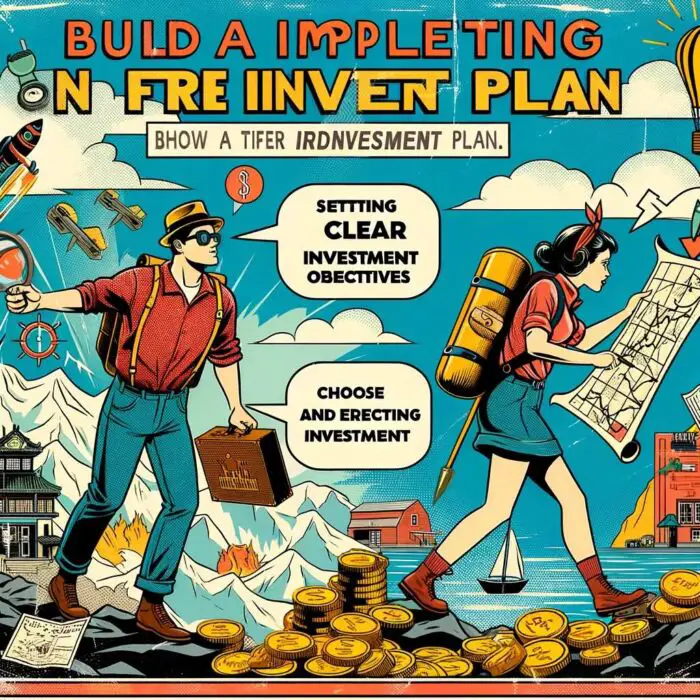
Creating a FIRE investment plan is a bit like planning an epic adventure. You need a clear destination in mind, and a set of objectives to guide you on your journey.
Your main objective is likely to accumulate enough wealth to live comfortably without a regular paycheck. However, you should break down this overarching goal into smaller, more manageable targets. These might include saving a certain amount each month, reaching specific net worth milestones, or achieving a desired annual rate of return on your investments.
Remember, objectives should be SMART – Specific, Measurable, Achievable, Relevant, and Time-bound. This makes them more tangible and gives you a clear path to follow on your FIRE adventure.
Choosing the Right Mix of Investments
Picking your investments for your FIRE portfolio is like packing for your adventure. You need to choose the right mix of items to help you on your journey and prepare you for various conditions.
Your mix should ideally include a range of asset classes – stocks, bonds, real estate, etc. – in line with the diversification principle discussed earlier. How much you allocate to each depends on your risk tolerance and investment horizon.
For instance, if you’re young and have a high risk tolerance, you might decide to invest heavily in stocks for their high growth potential. As you get closer to your FIRE goal, you might shift more towards bonds and other more stable assets to protect your accumulated wealth.
Reviewing and Adjusting Your Investment Strategy
Even the best-laid plans can go awry, and the journey to FIRE is no exception. Market conditions can change, personal circumstances can evolve, and goals can shift. That’s why it’s crucial to review and adjust your investment strategy regularly.
Regular reviews – say, annually or semi-annually – allow you to check your progress towards your FIRE objectives and make sure your investment strategy is still on track. If you’ve veered off course, it’s time to adjust your sails. This might involve rebalancing your portfolio, adjusting your savings rate, or reevaluating your risk tolerance.
Adjustments might also be necessary as you hit major life milestones or experience significant life changes, such as marriage, having kids, or changing careers. Each of these events can impact your financial situation and goals, and your investment strategy needs to keep pace.
Embarking on the FIRE journey takes courage and determination. But with a clear plan in place, the right mix of investments in your backpack, and a commitment to regular check-ins and adjustments, you can navigate the path to financial independence and early retirement with confidence.
In the final section, we’ll explore how to live the FIRE lifestyle and manage your wealth once you’ve reached your destination.
Conclusion
Like the final scene in an epic movie, it’s time to look back at the journey we’ve taken through the fascinating world of FIRE and investing. We started by understanding the basics of investing, highlighting the critical role it plays in achieving FIRE. We learned about setting financial goals, calculating our FIRE number, and how investing in a blend of stocks, bonds, real estate, and using tax-advantaged accounts can fast-track our way to early retirement.
We also dove into the importance of diversification and asset allocation in creating a robust, weather-resistant investment portfolio. We tackled the topic of risk management, emphasizing the importance of insurance and adjusting investment strategies as we approach our FIRE goals.
Then, we explored the process of building and implementing a comprehensive FIRE investment plan, complete with clear objectives, a well-thought-out mix of investments, and a commitment to regular review and adjustments.

FIRE Journey Through Strategic Investing
Stepping onto the path to FIRE might seem daunting. It’s a bit like standing at the foot of a mountain, looking up at the peak and wondering how you’ll ever make it to the top. But remember, every epic journey starts with a single step.
Your first step might be to read up more about FIRE, or to start tracking your expenses, or to make that initial investment in an index fund. Whatever it is, take that step with confidence and curiosity, like a true adventurer ready to conquer new lands.
Remember, the path to FIRE isn’t a sprint; it’s a marathon. There will be steep climbs, rocky paths, and perhaps even moments when you question why you embarked on this journey. But there will also be breathtaking views, exhilarating milestones, and the profound satisfaction of seeing your progress as you move closer to your goal.
The beauty of FIRE isn’t just the destination – the ability to retire early and live on your own terms. It’s also in the journey, the financial wisdom you gain, the habits you form, the mindset you cultivate, and the freedom you discover along the way.
So, pack your financial backpack with the tools and strategies we’ve discussed in this article, lace up your investor’s boots, and take that first step towards your FIRE journey. The path ahead is exciting, the potential rewards are immense, and the time to start is now. May your FIRE journey be as rewarding and enriching as the destination itself. Onward, fellow adventurers!
Important Information
Comprehensive Investment Disclaimer:
All content provided on this website (including but not limited to portfolio ideas, fund analyses, investment strategies, commentary on market conditions, and discussions regarding leverage) is strictly for educational, informational, and illustrative purposes only. The information does not constitute financial, investment, tax, accounting, or legal advice. Opinions, strategies, and ideas presented herein represent personal perspectives, are based on independent research and publicly available information, and do not necessarily reflect the views or official positions of any third-party organizations, institutions, or affiliates.
Investing in financial markets inherently carries substantial risks, including but not limited to market volatility, economic uncertainties, geopolitical developments, and liquidity risks. You must be fully aware that there is always the potential for partial or total loss of your principal investment. Additionally, the use of leverage or leveraged financial products significantly increases risk exposure by amplifying both potential gains and potential losses, and thus is not appropriate or advisable for all investors. Using leverage may result in losing more than your initial invested capital, incurring margin calls, experiencing substantial interest costs, or suffering severe financial distress.
Past performance indicators, including historical data, backtesting results, and hypothetical scenarios, should never be viewed as guarantees or reliable predictions of future performance. Any examples provided are purely hypothetical and intended only for illustration purposes. Performance benchmarks, such as market indexes mentioned on this site, are theoretical and are not directly investable. While diligent efforts are made to provide accurate and current information, “Picture Perfect Portfolios” does not warrant, represent, or guarantee the accuracy, completeness, or timeliness of any information provided. Errors, inaccuracies, or outdated information may exist.
Users of this website are strongly encouraged to independently verify all information, conduct comprehensive research and due diligence, and engage with qualified financial, investment, tax, or legal professionals before making any investment or financial decisions. The responsibility for making informed investment decisions rests entirely with the individual. “Picture Perfect Portfolios” explicitly disclaims all liability for any direct, indirect, incidental, special, consequential, or other losses or damages incurred, financial or otherwise, arising out of reliance upon, or use of, any content or information presented on this website.
By accessing, reading, and utilizing the content on this website, you expressly acknowledge, understand, accept, and agree to abide by these terms and conditions. Please consult the full and detailed disclaimer available elsewhere on this website for further clarification and additional important disclosures. Read the complete disclaimer here.




